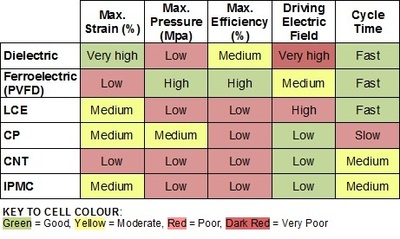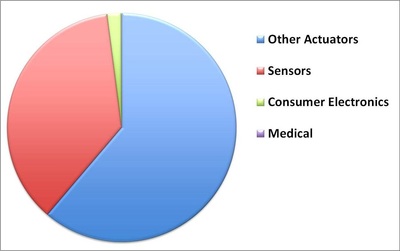Electroactive polymers market worth $2.25bn
Electroactive polymers have been used for some time in actuators, capacitors and nanocomposites but, with new recent technical progress, come new growth opportunities - despite several decades of research and development and first applications, the EAP field is still far from mature.
The electroactive polymers market (EAP) market will be US$245m in 2013, according to IDTechEx Research (EAP) market.
The research firm forecasts the market potential to be as high as US$2.25bn by 2018, dominated by consumer electronics, actuators and sensors applications. The new IDTechEx Research report ‘Electroactive Polymers and Devices 2013-2018: Forecasts, Technologies, Players’ explores the market fully for the next six years, but what will the next couple of years bring?
EAP introduction
EAPs are part of the broad group of smart materials. The use of polymers with electroactive response has only emerged in the last decade with the introduction of new materials which have significant displacement levels. These materials are highly attractive for their low-density, large strain capability, superior spectral response and resilience. In general, the biggest advantages over conventionally used systems in most application fields are the intermittent displacement they can provide, an adaptable stiffness combined with variable size and form factors from micrometres to metres. Companies like Artificial Muscle (AMI), part of Bayer Materials Science, and Strategic Polymers (SPS) have been able to tune the properties even further. AMI’s dielectric EAP-based actuator has an average power consumption of just 1.5 mW and already passed mobile qualification tests. And SPS’s PVDF terpolymer-based EMP actuators show comparable high deformation strain in the range of 0.5 to 2.5%.
The following matrix shows a comparison of the main EAP types by maximum strain, pressure and efficiency, as well as the driving electric field and cycle time.

Source: IDTechEx report ‘Electroactive Polymers and Devices 2013-2018: Forecasts, Technologies, Players’
Variety of applications
The market potential is huge - EAPs can be used in various applications including actuators and sensors, biomimetic and robotics, energy harvesting and storage devices etc. Dielectric sensors are already in use for a wide range of applications; for example, surface or bulk measurements sensors. In the actuators segment, vast research and development activity can be seen for specialised applications such as medical devices and biomimetic-robotics. Here, the features of electroactive polymers are used to enable movement and generate force as well as electrically control surface properties. However, these are very demanding markets, with high performance requirements and restrictions. This is why it will take at least five more years before revenues grow significantly.
Existing markets
Dielectric elastomer materials are already in high production and are commercially available from sources like 3M. However, these materials are not universally suitable. The main issue hindering the widespread application of dielectric elastomers is the high operating voltage required. New growth needs to come from new innovation - improved materials suitable for less demanding high-volume applications, such as consumer electronics and large-area thin-film sensors.
Focus on haptics
Implementation of EAPs for haptic feedback, especially for handheld touchscreen devices and peripherals, is the current new market focus. First prototypes have been introduced by Strategic Polymers and Artificial Muscle of Bayer Materials Science. One of the biggest challenges at the moment is the cost of EAP devices in consumer electronics. This is why high-fidelity and large-screen applications will come first.
Energy harvesting
Research is ongoing on whether EAP-based systems can be used to harvest energy from sea waves. In comparison to conventionally used hydraulic systems, EAP-based systems offer lower production costs and higher durability.
IDTechEx forecasts
IDTechEx estimates the electroactive polymer market volume to grow almost tenfold in the next five years, dominated by consumer electronics (38%), actuators and sensors applications. The most prominent application is haptics for portable consumer devices with a touch screen. Sensors come next. For energy-harvesting applications, especially from ocean waves, it will take another decade until the market will see first commercial penetration. The following chart gives the market size by value of the finished device (including driving components etc).

Source: IDTechEx report ‘Electroactive Polymers and Devices 2013-2018: Forecasts, Technologies, Players’
Outlook
Actuators and sensors are the most common application for electroactive polymers today and will remain prominent in the next five years. The highest potential lies in new application fields, such as consumer electronics, where first prototypes and evaluation studies have been recently demonstrated. Intensive research and development towards better efficiency, long-term stability, saltwater resistance and up-scale of production from laboratory state to commercial production is needed.
For the full forecasts and more detailed information on electroactive polymers, global players and applications, such as actuators, sensors and energy harvesting, please see the new IDTechEx report ‘Electroactive Polymers and Devices 2013-2018: Forecasts, Technologies, Players’.
Unlocking next-gen chip efficiency
By studying how heat moves through ultra-thin metal layers, researchers have provided a...
Ancient, 3D paper art helps shape modern wireless tech
Researchers have used ancient 3D paper art, known as kirigami, to create tuneable radio antennas...
Hidden semiconductor activity spotted by researchers
Researchers have discovered that the material that a semiconductor chip device is built on,...






